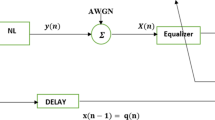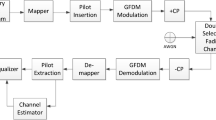Abstract
In this paper, a new approach is proposed for implementing an adaptive decision feedback equalizer (ADFE) for the 5G channel. The proposed equalizer works in two phases. In the first phase, a least-squares (LS) algorithm with a variable-length training sequence is used to estimate the coefficients of the channel and the equalizer. In the second phase, the recursive least-squares algorithm estimates the channel and adapts the equalizer, jointly. According to the channel quality, a variable-length training sequence is used to estimate the channel vector and the coefficients of the equalizer. The feed-forward equalizer (FFE) compensates the effects of the transmitting filter and the channel filter. No matched filter is used in the receiver. The noise samples at the input of the proposed FFE are independent. The noise enhancement of the proposed FFE is less than the noise enhancement of its corresponding one in the conventional ADFE. The overall filtering response (OFR) from the input of the transmitting filter to the output of the FFE is calculated and used to estimate the coefficients of the feedback equalizer (FBE). The channel model, the FFE coefficients, the OFR vector, and the FBE coefficients are continuously updated every symbol period. Using a variable training sequence increases the bandwidth efficiency of the transmitted signal. Simulation results and real-time implementation measurements show that the convergence time and the steady-state error at the output of the proposed equalizer are smaller than their corresponding values in the conventional ADFE.













Similar content being viewed by others
References
ETSI TS 123 501. (2018–06). 5G; system architecture for the 5G system. 3GPP TS 23.501 version 15.2.0, Release 15. https://www.etsi.org/deliver/etsi_ts/123500_123599/123502/15.02.00_60/ts_123502v150200p.pdf.
5G PPP Architecture Working Group. View on 5G architecture. Version 3.0. https://5g-ppp.eu/wp-content/uploads/2019/07/5G-PPP-5G-Architecture-White-Paper_v3.0_PublicConsultation.pdf.
ETSI EN 300 744. (2004–06). Digital video broadcasting (DVB); framing structure, channel coding and modulation for digital terrestrial television, Version 1.5.1. https://www.etsi.org/deliver/etsi_en/300700_300799/300744/01.05.01_40/en_300744v010501o.pdf.
ETSI EN 300 421. Digital video broadcasting (DVB); framing structure, channel coding and modulation for 11/12 GHz satellite services. Version 1.1.2. https://www.etsi.org/deliver/etsi_en/300400_300499/300421/01.01.02_60/en_300421v010102p.pdf.
ETSI EN 300 429. Digital video broadcasting (DVB); framing structure, channel coding and modulation for cable systems. Version 1.2.1. https://www.etsi.org/deliver/etsi_en/300400_300499/300429/01.02.01_60/en_300429v010201p.pdf.
Middlestead, R. W. (2017). Adaptive systems. In: Digital communications with emphasis on data modems: Theory, analysis, design, simulation, testing, and applications (pp. 463–484). Wiley. https://doi.org/10.1002/9781119011866.ch12
Middlestead, R. W. (2017). Communications through bandlimited time‐invariant linear channels. In: Digital communications with emphasis on data modems: Theory, analysis, design, simulation, testing, and applications (pp. 617–631). Wiley. https://doi.org/10.1002/9781119011866.ch17
Kim, H. (2015). Channel estimation and equalization. In: Wireless communications systems design (pp.279–299). Wiley. https://doi.org/10.1002/9781118759479.ch9
Haykin, S. (1996). Adaptive filter theory (3rd ed.). Prentice-Hall Inc.
Proakis, J. G. (2007). Digital communications, 5th edn. McGraw Hill
Parida, A. K., Panda, S., & Singh, R. P. (2019) A strategy on channel equalization for digital communication based on neural network system. In: 2019 5th international conference on advanced computing & communication systems (ICACCS), Coimbatore, India (pp. 152–156). https://doi.org/10.1109/ICACCS.2019. 8728472
Caciularu, A., & Burshtein, D. (2020). Unsupervised linear and nonlinear channel equalization and decoding using variational autoencoders. IEEE Transactions on Cognitive Communications and Networking, 6(3), 1003–1018. https://doi.org/10.1109/TCCN.2020.2990773
Santos, I., Murillo-Fuentes, J. J., Aradillas, J. C., & Arias-De-Reyna, E. (2020). Channel equalization with expectation propagation at smoothing level. IEEE Transactions on Communications, 68(5), 2740–2747. https://doi.org/10.1109/TCOMM.2020.2975624
ETSI TR 138 900. (2017–06). LTE; 5G; Study on channel model for frequency spectrum above 6 GHz. 3GPP TR 38.900 version 14.2.0, Release 14.
Li, Q., Teh, K. C., & Li, K. H. (2013). Low-complexity channel estimation and turbo equalization for high-frequency channels. IET Communications, 7(10), 980–987. https://doi.org/10.1049/iet-com.2012.0811
Vahidi, V., Pour Yazdanpanah, A., Saberinia, E., & Regentova, E. E. (2016). Channel estimation, equalization, and evaluation for high-mobility airborne hyperspectral data transmission. IET Communications, 10(18), 2656–2662. https://doi.org/10.1049/iet-com.2016.0599
Na, Z., et al. (2018). Turbo receiver channel estimation for GFDM-based cognitive radio networks. IEEE Access, 6, 9926–9935. https://doi.org/10.1109/ACCESS.2018.2803742
Wu, S., Wang, C., Aggoune, E. M., Alwakeel, M. M., & You, X. (2018). A general 3-D non-stationary 5G wireless channel model. IEEE Transactions on Communications, 66(7), 3065–3078. https://doi.org/10.1109/TCOMM.2017.2779128
Rappaport, T. (2001). Wireless communications: Principles and practice (2nd ed.). Prentice-Hall PTR.
Hassan, A. Y. (2015). A wideband QAM receiver based on DFE to reject ISI in wireless time-varying fading channel. AEU International Journal of Electronics and Communications, 69(1), 332–343. https://doi.org/10.1016/j.aeue.2014.10.005 ISSN 1434-8411.
Karan, Y., & Kahveci, S. (2016). LMS and RLS equalizer performances of ultra-wideband system in body area network channel. In: 2016 24th signal processing and communication application conference (SIU), Zonguldak (pp. 285–288). https://doi.org/10.1109/SIU.2016.7495733
Irfan, R., Ur Rasheed, H., Toor, W. A., & Ashraf, M. (2019). Performance analysis of adaptive algorithms for space-time adaptive processor (STAP) in phased array radar. The Journal of Engineering, 19, 6313–6317. https://doi.org/10.1049/joe.2019.0234
Li, T., & Torlak, M. (2018). Performance of ZF linear equalizers for single carrier massive MIMO uplink systems. IEEE Access, 6, 32156–32172. https://doi.org/10.1109/ACCESS.2018.2841032
Ayvaz, E. N., Maraş, M., & Özen, A. (2018). A fast start-up modified LMS algorithm. In: 2018 26th signal processing and communications applications conference (SIU), Izmir (pp. 1–4). https://doi.org/10.1109/SIU.2018.8404487
Author information
Authors and Affiliations
Corresponding author
Additional information
Publisher's Note
Springer Nature remains neutral with regard to jurisdictional claims in published maps and institutional affiliations.
Rights and permissions
About this article
Cite this article
Hassan, A.Y. A new approach for designing and implementing ADF equalization for 5G frequency selective channel based on two operating phases of LS and RLS algorithms. Telecommun Syst 77, 543–562 (2021). https://doi.org/10.1007/s11235-021-00778-x
Accepted:
Published:
Issue Date:
DOI: https://doi.org/10.1007/s11235-021-00778-x




